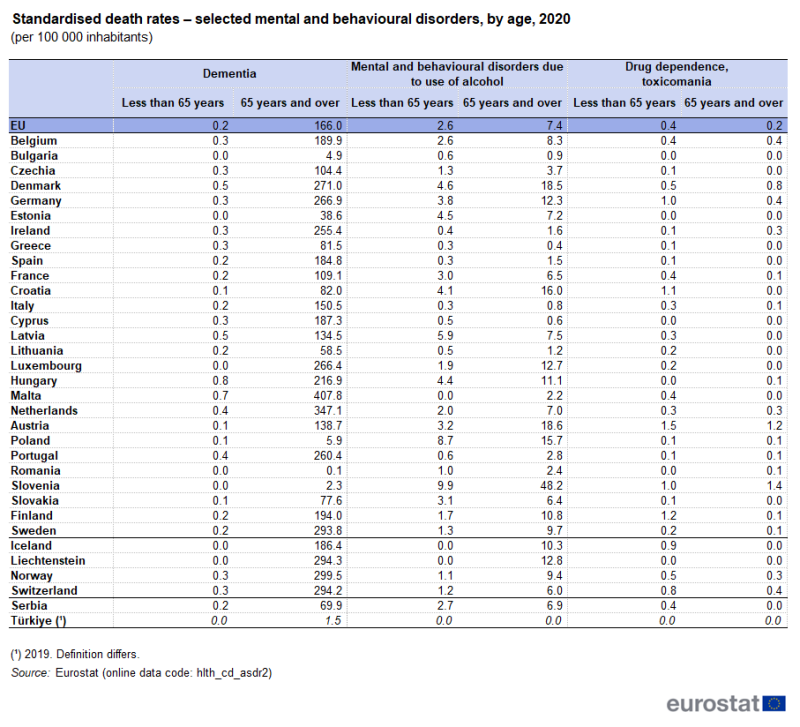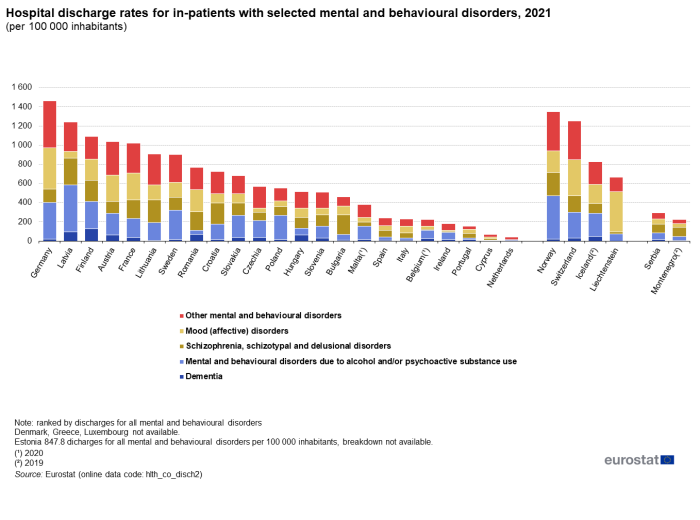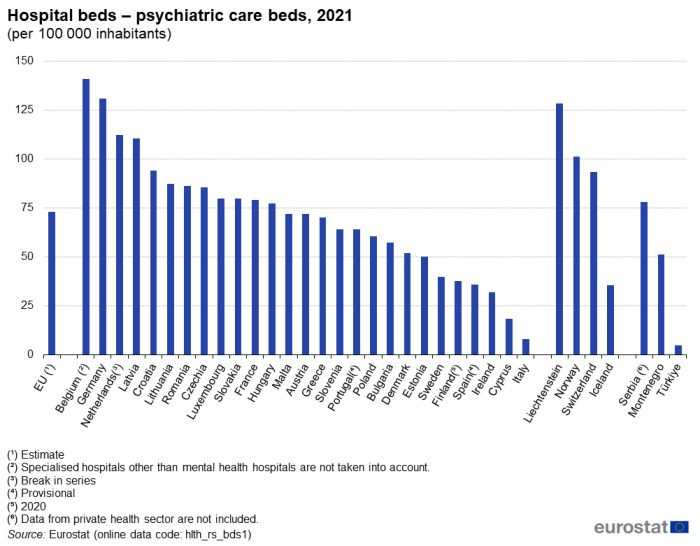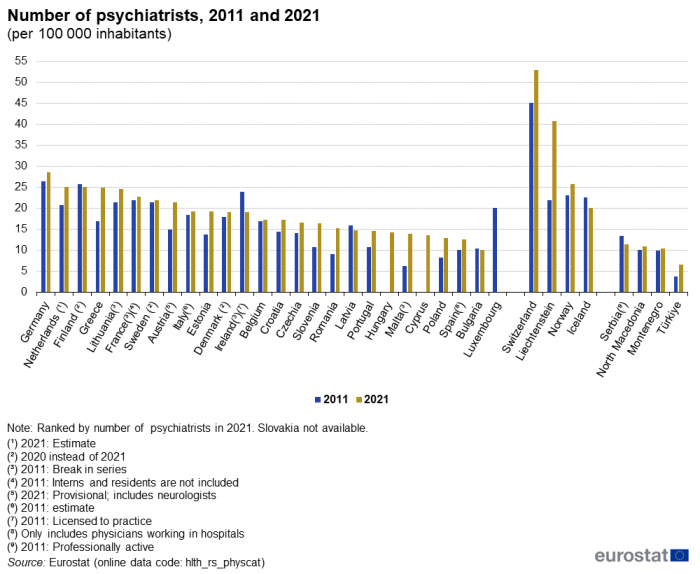Mental health and related issues statistics
Data extracted in September 2023.
Planned article update: 10 October 2024.
Highlights
3.7 % of all deaths in the EU in 2020 resulted from mental and behavioural disorders.
Dementia was the most common cause of death from mental and behavioural disorders in the EU, in 2020.
In 2021 there were 3.1 million in-patients with mental and behavioural disorders who were discharged from hospitals in 24 of the EU Member States for which data are available.
This article presents an overview of European Union (EU) statistics related to mental and behavioural disorders and intentional self-harm (which is an external cause of morbidity and mortality). Mental and behavioural disorders include, for example, dementia (chronic or persistent mental disorders characterised by memory disorder, personality change and impaired reasoning), schizophrenia, and psychoactive substance use disorders (such as alcohol or drug dependence). This article covers deaths from mental and behavioural disorders, healthcare for mental and behavioural disorders; and the availability of specialist healthcare resources (beds and personnel) for the treatment of mental and behavioural disorders.
This article is 1 of a set of statistical articles concerning healthcare activities in the EU which forms part of an online publication on Health in the European Union – facts and figures.
While most data in this article relate to 2020 and 2021, there are some for 2019. This article includes data that may have been impacted by the COVID-19 pandemic and its related restrictions. For this reason, particular attention should be paid when comparing the 2020 data with data from earlier years.
It is widely acknowledged that the COVID-19 pandemic impacted the population's mental health, for example through reduced social contact. In some EU Member States, healthcare resources were placed under intense pressure (particularly at the start of the pandemic) from an influx of patients with COVID-19. The pandemic also resulted in a range of knock-on effects including, among others, some services being curtailed/postponed due to the number of COVID-19 patients, staff shortages within hospitals and day care centres due to infection/quarantine procedures, and patients being hindered access to medical services due to their own infection/quarantine as well as lockdown or travel restrictions.
Full article
Deaths from mental and behavioural disorders and intentional self-harm
In 2020, there were 194 000 deaths in the EU resulting from mental and behavioural disorders, equivalent to 3.7 % of all deaths. Relative to the population, there were 39 deaths from mental and behavioural disorders per 100 000 inhabitants in the EU in 2020.
Mental and behavioural disorders were a particularly common cause of death at advanced ages. The EU standardised death rate from mental and behavioural disorders in 2020 for those aged 65 years and over was 44 times as high as the standardised death rate for persons aged less than 65 years. This can be compared with the same ratio for all causes of death, where the death rate for those aged 65 years and over was 22 times as high.
Among mental and behavioural disorders, dementia was the most common causes of death in the EU among those over 65 years

(per 100 000 inhabitants)
Source: Eurostat (hlth_cd_asdr2)
A more detailed analysis of causes of death for a selection of mental and behavioural disorders is presented in Table 1. The leading cause of death from mental and behavioural disorders was dementia, which accounts for 83 % of all deaths from mental and behavioural disorders in the EU in 2020. The standardised death rate for those over 65 years was 166 deaths from dementia per 100 000 people over 65 years in 2020; this is over 790 times higher than the standardised death rate for dementia in those under 65 years (0.2 per 100 000 people under 65 years).
The highest standardised death rate for dementia in those over 65 years was recorded in Malta (407.8 deaths from dementia per 100 000 people aged over 65 years), followed by the Netherlands (347.1 deaths from dementia per 100 000 people aged over 65 years). The lowest standardised death rates were reported in Romania, Slovenia and Bulgaria (all under five deaths from dementia per 100 000 people aged over 65 years).
The second leading cause of death from mental and behavioural disorders was due to the use of alcohol. This was also the leading cause of death from mental and behavioural disorders in those under 65 years, with 2.6 deaths per 100 000 people under 65 years; this accounts for 64 % of deaths from mental and behavioural disorders in this age group. Slovenia reported the highest standardised death rate for deaths from mental and behavioural disorders due to the use of alcohol in both age groups (9.9 in the younger age group and 48.2 in the older age group).
In 2020, the only mental and behavioural disorder in the EU for which the standardised death rate was higher among those under 65 years was for drug dependence, also known as toxicomania. Analysis by country shows that in both age groups the standardised death rate for toxicomania ranged between 0.0 and 1.5 deaths per 100 000 inhabitants. This standardised death rate was higher for those under 65 years in 17 of the 27 Member States.
Males were 3.8 times as likely as females to die from intentional self-harm
In 2020, the standardised death rate for intentional self-harm (ICD10 codes X60–84 and Y87.0) was 10.2 per 100 000 inhabitants for the EU, with the rate for males 3.8 times as high as that for females (see Figure 1). It should be noted that the comparability of data on intentional self-harm is thought to be limited due to an under reporting of suicides in some EU Member States (possibly due to cultural stigma and other reasons).

(per 100 000 inhabitants)
Source: Eurostat (hlth_cd_asdr2)
Across the EU Member States, the highest standardised death rate for intentional self-harm in 2020 was recorded for Lithuania (21.3 per 100 000 inhabitants), followed at some distance by Hungary, Slovenia, Estonia, Latvia and Belgium, each with rates within the range of 15.0–17.1 per 100 000 inhabitants. Rates between 5.0 and 13.5 per 100 000 inhabitants were recorded for most of the other EU Member States, Greece, Malta (both 4.0 per 100 000 inhabitants) and Cyprus (3.5 per 100 000 inhabitants) below this range.
In all EU Member States, standardised death rates for intentional self-harm for males were higher than those for females in 2020, ranging from 1.9 times as high in Malta to 7.3 times as high in Poland. The largest absolute difference was recorded in Lithuania, where the rate for females was 8.0 per 100 000 inhabitants and the rate for males was 38.0 per 100 000 inhabitants.
Mental healthcare
In 2021 there were 3.1 million in-patients with mental and behavioural disorders who were discharged from hospitals in the EU Member States for which data are available (2020 data for Germany and Malta; no recent data for Denmark, Greece and Luxembourg). In Germany, there were 1.2 million in-patient discharges among people treated for mental and behavioural disorders in 2021. There were only two other EU Member States that recorded in excess of 200 000 in-patient discharges in 2021 – France and Poland – while these diseases accounted for less than 10 000 in-patient discharges in Ireland, the Netherlands, Malta and Cyprus.
Relative to population size, Germany recorded the highest number of in-patient discharges for mental and behavioural disorders in 2021, with 1 463 discharges per 100 000 inhabitants. Latvia, Finland, Austria and France also recorded more than 1 000 in-patient discharges for mental and behavioural disorders per 100 000 inhabitants. This was 15 times as high as the equivalent ratios for Cyprus and the Netherlands, where the lowest rates were recorded (68 and 40 in-patient discharges per 100 000 inhabitants, respectively). In the other Member States for which data are available this rate was between 153 and 908 in-patient discharges per 100 000 inhabitants.
Figure 2 shows the breakdown of discharges by diagnosis, for selected mental and behavioural disorders. Dementia accounted for the smallest proportion of hospital discharges in 19 of the 23 EU Member States for which data are available, ranging from 1.4 discharges per 100 000 inhabitants in the Netherlands, to 126.6 discharges from dementia per 100 000 inhabitants in Finland.

(per 100 000 inhabitants)
Source: Eurostat (hlth_co_disch2)
In 2021, mental and behavioural disorders due to alcohol and/or psychoactive substance use accounted for 33 % of hospital discharges from mental and behavioural disorders in the EU (no data for Denmark, Greece and Luxembourg). The highest number of discharges relative to the population from mental and behavioural disorders due to alcohol and/or psychoactive substance use was reported in Estonia with 485.7 hospital discharges per 100 000 inhabitants. The lowest number of discharges was reported in the Netherlands and Cyprus, with 9.9 and 3.6 discharges per 100 000 inhabitants, respectively). In the other Member States for which data are available this figure ranged from 18 to 382 discharges per 100 000 inhabitants.
Schizophrenia, schizotypal and delusional disorders, and mood (affective) disorders accounted for 27 % and 24 % of hospital discharges from mental and behavioral discharges among the EU Member States for which data are available. These figures varied greatly between Member States.
Particularly long average length of stay for in-patients with mental and behavioural disorders
Figure 3 presents an analysis of the average length of hospital stays for in-patients treated for mental and behavioural disorders and for all causes in 2021. The average length of stay for in-patients treated for mental and behavioural disorders ranged from 9.4 days in Belgium (2020 data) and 9.5 days in the Netherlands, and up to 53.1 days in Spain and 43.4 days in Czechia.
In nearly all of the EU Member States, these were the longest average lengths of stay of all the categories in the International Shortlist for Hospital Morbidity Tabulation (ISHMT). Only Belgium, Italy and Cyprus recorded a higher average length of stay for a different category. The average length of stay for in-patients treated for mental and behavioural disorders was 1.5 and 1.7 times higher than the average for all causes in Belgium and the Netherlands; and was 6.6 and 6.8 times higher in Spain and Bulgaria.

(days)
Source: Eurostat (hlth_co_inpst)
Healthcare beds and personnel
Increasing numbers of psychiatrists in most Member States
In 2021, there were 327 000 psychiatric care beds in hospitals in the EU, equivalent to 14 % of all hospital beds.
Figure 4 presents data for the number of psychiatric care beds in hospitals relative to the size of population in 2021. Belgium reported the highest number of psychiatric care beds in hospitals, with 141 psychiatric care beds per 100 000 inhabitants. Germany, the Netherlands (break in series) and Latvia also recorded more than 100 psychiatric care beds per 100 000 inhabitants. Italy was the only country to report less than 10 psychiatric care beds per 100 000 inhabitants (8.0). In the other Member States the number of psychiatric care beds was between 18.4 and 94.0 per 100 000 inhabitants.

(per 100 000 inhabitants)
Source: Eurostat (hlth_rs_bds1)
Relative to the population, the number of psychiatrists rose in the vast majority of EU Member States between 2011 and 2021. There was an increase recorded in 19 out of the 23 Member States for which data are available (only partial data for Luxembourg and no recent data for Slovakia). The biggest increases were in Greece, Malta, Austria and Romania, where the number of psychiatrists increased by more than 6.0 per 100 000 inhabitants between 2011 and 2021. By contrast, Ireland reported the greatest fall in the number of psychiatrists relative to population size: down 4.9 psychiatrists per 100 000 inhabitants (note the break in series). Latvia, Finland and Bulgaria were the only other Member States to report a fall in their number of psychiatrists relative to population size; in each case the reduction was smaller than 1.2 per 100 000 inhabitants.

(per 100 000 inhabitants)
Source: Eurostat (hlth_rs_physcat)
Direct access to
Online publications
Causes of death
Healthcare activities
Methodology
General health statistics articles
- Health (t_hlth), see:
- Health care (t_hlth_care)
- Causes of death (t_hlth_cdeath)
- Health (hlth), see:
- Health status (hlth_state)
- Self-reported chronic morbidity (hlth_srcm)
- Persons reporting a chronic disease, by disease, sex, age and educational attainment level (hlth_ehis_cd1e)
- Self-reported chronic morbidity (hlth_srcm)
- Health care (hlth_care)
- Health care resources (hlth_res)
- Health care staff (hlth_staff)
- Health care facilities (hlth_facil)
- Health care activities (hlth_act)
- Hospital discharges and length of stay for in-patient and curative care (hlth_co_dischls)
- Hospital discharges - national data (hlth_hosd)
- Length of stay in hospital (hlth_hostay)
- Consultations (hlth_consult)
- Self-reported consultation of mental healthcare or rehabilitative care professionals by sex, age and educational attainment level (hlth_ehis_am6e)
- Health care resources (hlth_res)
- Causes of death (hlth_cdeath)
- General mortality (hlth_cd_gmor)
- Causes of death - deaths by country of residence and occurrence (hlth_cd_aro)
- Causes of death - standardised death rate by NUTS 2 region of residence (hlth_cd_asdr2)
- General mortality (hlth_cd_gmor)
- Health status (hlth_state)
Atlas
News releases
- Causes of death (SIMS metadata file – hlth_cdeath_sims.htm)
- European health interview survey (ESMS metadata file – hlth_det_esms)
- Healthcare non-expenditure statistics (ESMS metadata file – hlth_res)
- European Health Interview Survey (EHIS wave 3) – Methodological manual – 2018 edition
